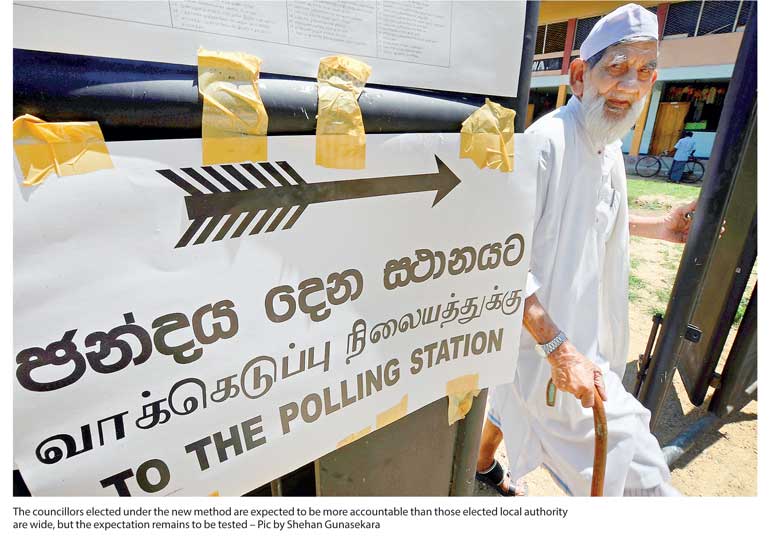Friday Dec 05, 2025
Friday Dec 05, 2025
Friday, 5 January 2018 00:00 - - {{hitsCtrl.values.hits}}

 The local elections are scheduled to take place on 10 February, after a long period of anticipation.
The local elections are scheduled to take place on 10 February, after a long period of anticipation.
As a country, we have been talking about electoral reforms since 2003. Though not perfect, we now have an electoral system for local government that satisfies the requirements of proportional representation for political parties while giving representation closer to home for voters. The long process of formulating the method was completed in 2017. The focus is now on campaigning to influence voter preferences.
Ideally, in local elections, voters should select individuals who will address local problems. But, local elections have never been local. They are played on the national arena. After the election is over and winners are declared, the big players go back to wherever, leaving the rate payers to live with the result for four years or so.
The new method is expected to make elections more local by incorporating First-Past-the-Post (FPP) contests to elect members by wards which are smaller sub-units in a local authority area. These FPP contests are carried out within a larger Proportional Representation (PR) framework where each party is allocated seats in proportion to the totality of votes they received in the wards.
In regard to the Colombo Municipal Council, the larger PR framework has 110 seats. FPP contests are used to fill only 66 seats. The other 44 seats are filled from party lists which were submitted at the time of nomination as additional-persons lists. The list seats are used to compensate for any deviations from proportionality in FPP results. This method of election where two different methods are used to return members is called a Mixed-Member Proportional (or MMP). In contrast, previously we used a single method – i.e. results of preferential voting – to return members.
MMP method is found only in a handful of countries in the world. Several countries have tried MMP but reverted to PR or other mixed-member methods, but Bolivia, Lesotho, Germany, New Zealand and Scotland have successfully adopted the method. South Africa applies MMP for local government but not for provincial or national level.
Present election presents a necessary experiment for Sri Lanka, because we have been talking about mixed-member methods since 2003 and not taken steps to implement. Whether we want to continue with the method or not is a matter for consideration after a few years of implementation.
At the polling booth on 10 February, each voter will be presented with a ballot paper which is quite simple. It will consist of a set of party symbols and the names corresponding to the symbols. Each party would have nominated one or more candidate for each ward, but their names will not appear on the ballot.
For example, Rosy Senanayake, the mayor designate of UNP, is contesting in the Bambalapitiya ward against other candidates from UPFA, SLPP, JVP and several small parties. Mayor designate from the SLFP, Azath Salley, is contesting in the Kochchikade ward against a similar number of candidates from other parties. The names of any of the candidates, well known or not, will not appear on the ballot. It is up to the candidates to introduce themselves to the voters in their ward as the name behind the party symbol.
Votes will be cast and counted at the ward level. Colombo will return 66 FPP members from 47 wards. The number of members is higher than the number of wards because there are several are multi-member wards in the CMC. In a dual-member ward, for example, each party will field two candidates and the party that gets the most votes in that ward gets to return both candidates as councillors.
The votes received by each party at the ward level will be totalled to obtain each party’s share of votes in the local authority as a whole.
Releasing the results would be a daunting task for the Elections Commission (EC). Firstly, some parties may win more FPP seats than their PR entitlement. This excess is called an overhang. For example, if party A receives 45% of the total votes, it will be entitled to occupy 49 seats out of 110 seats in the CMC. However, there is a reasonable chance that party A might win 50 or more of the 66 FPP contests, making it necessary to create additional seats in the council or make other adjustments to accommodate the additional FPP wins.
Secondly, the EC is mandated to make sure that 25% or more of the members in the council are female. In some cases, sufficient women may not be returned. In such a scenario, the number of seats in a council may have to be increased to bring the number of females up to the mandated 25%.
Both scenarios depend on voter behaviour. The legislation seems to give the EC the flexibility to manage above scenarios as they arise. There is nothing we can do but put our trust in the EC and do our duty by going to the polling both on 10 February.
If party A receives a majority of seats in the council, the secretary of the party will nominate the mayor or the chairman for the council. If not, the mayor or chairman will be elected at the first meeting of the council. The chairman or the mayor along with the council staff will function as the executive arm of the local authority, while the council of members is expected to serve as the policymaking and oversight body. As has been the practice in CMC since 2000 or so, CMC council members get a certain amount of money and resource to do development work of their choice.
The councillors elected under the new method are expected to be more accountable than those elected local authority are wide, but the expectation remains to be tested. In the past, councillors engaged in unlawful activities such as using proxies to procure local authority contract for themselves. Will eyes closer to home stop such activities? We have to wait and see.
The new method does not give any guarantee of accountability of the councils or the mayor elected. Important polices on roads and other thoroughfares, public health and sanitation, public utilities such as child care centres, pre-schools, libraries, recreational facilities, crematoria and cemeteries have to be decided and executed, not at the ward level but at the council level as a whole.
Here, irrespective of the method of election, inefficiencies and even corrupt practices of the past may continue. Even if an elected mayor or chairman wants to perform, there will be lot of obstacles from rival political parties and vested interests.
Citizen charters are widely accepted as means of improving accountability in local government and supporting non-corrupt politicians. A citizen charter is “an official document that describes to the citizen in simple terms the step-by-step procedure for availing a particular service, and the guaranteed performance level that they may expect for that service.”
In 2011, the Indian Parliament passed a house resolution in which the ‘Right of Citizens for Time Bound Delivery of Goods and Services’ component provided a comprehensive mechanism to ensure the delivery of public services, social sector entitlements and the accountability of delivery systems. It obligated public authorities to enumerate all the services, goods and entitlements they are supposed to deliver to people in the form of enforceable citizen charters. This resolution was in response to demands by activist Anna Hazare and followers to curb corruption.
In a study of implementation of citizen charters in Philippines, India and UK, where citizen charters are mandated, Kidjie (2012) found that local authorities complied with the requirements but the charters were not as effective because citizen participation was low or there were no mechanisms to monitor.
In a self-evaluation of the progress of India’s ‘Right of Citizens for Time Bound Delivery of Goods and Services Act,’ the Department of Administrative Reforms and Public Grievances noted, among other things, that the charter initiative should have a built-in mechanism for monitoring, evaluating and reviewing the working of the Charters, preferably through an outside agency.
There is indeed a decentralised, people-friendly and time-bound process of registering and redressing complaints in the bill that was initially put forward as a package, but the grievance redress component of that package was not enacted. The proposed grievance procedures gave powers to the appellate bodies to penalise erring officials and compensate complainants.
The Bill sets up a central public grievances redressal commission – and an equivalent in every state. The details of the proposed grievance redress mechanisms and the reasons for inactivity of the Indian government in that regard should be further investigated.
Citizen participation is one of the performance criteria developed by the Ministry of Local Government and Provincial Councils to evaluate the performance of local authorities in their survey of local authorities. Specifically, the Ministry awards points for local authorities for ‘Community participation in decision making with formal delegation of powers’. Another criterion used is the extent to which ‘Activities of the councils are being executed in accordance with a citizen charter’.
Given that the Ministry already is using these performance criteria provides a good backdrop for mandating citizen charters, and formal delegation of powers to community participation through various advisory committees. As lessons from India and Philippines show, grievance redress mechanisms including an Ombudsmen office is also essential for citizen participation and oversight in local government. We can start with simple mechanisms like institutionalised citizen committees to monitor the implementation of citizen charters.